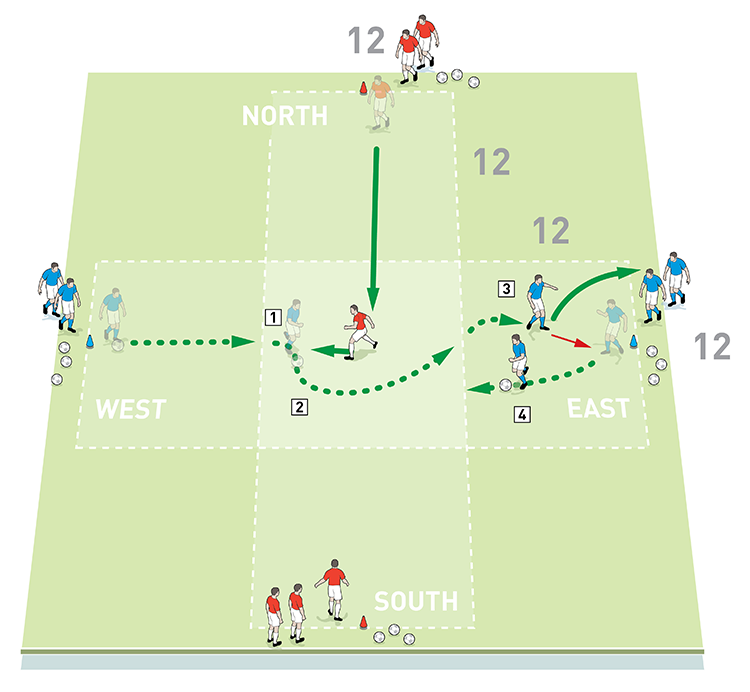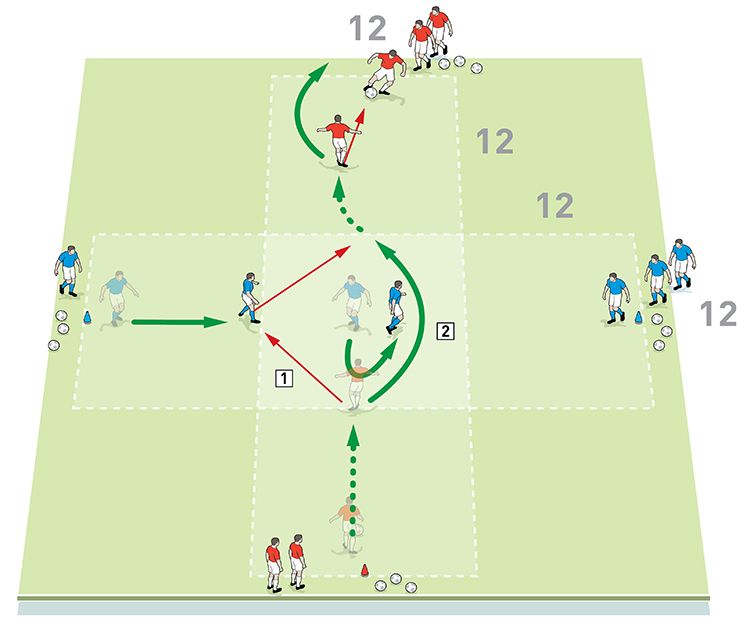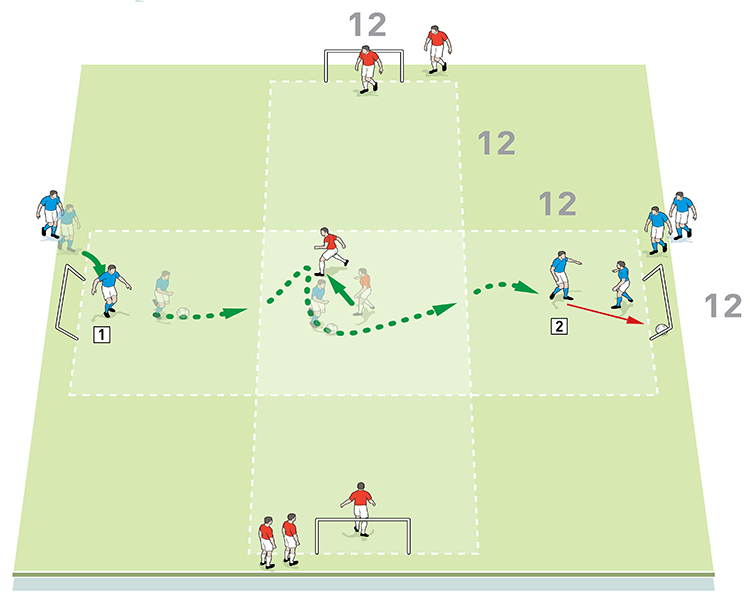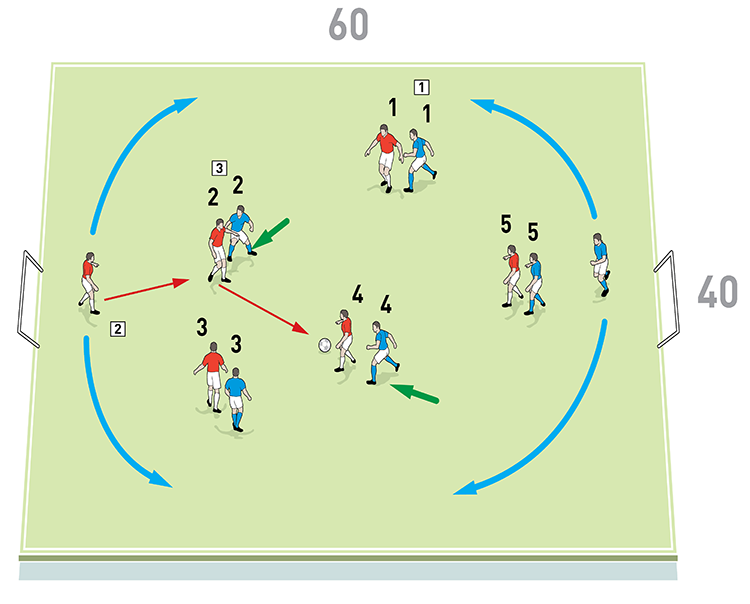




OUR BEST EVER OFFER - SAVE £100/$100
JOIN THE WORLD'S LEADING PROFESSIONAL DEVELOPMENT PROGRAMME
- 12 months membership of Elite Soccer
- Print copy of Elite Player & Coach Development
- Print copy of The Training Ground
You are viewing 1 of your 1 free articles
Defending 1v1
If players can take the ball off their opponent anywhere on the pitch, the team is better equipped to deal with an attacking overload, so get your players mastering the art of 1v1 defending.
| Area | Up to 60x40 yards |
| Equipment | Ball, bibs, cones and small goals |
| No. of Players | 12 players |
| Session Time | Total: 85mins, St Georges Cross 1v1: 15mins, Progression 1: 15mins, Progression 2 (with goals): 20mins, Small-sided game: 35mins |
This session is focused on 1v1 defending, which is a dying art. If players can take the ball off their opponent anywhere on the pitch, the team is better equipped to deal with an attacking overload.
I have chosen this session because too often I see a big emphasis put on players “on the ball” rather than highlighting the importance of their work “off the ball”. Being a good 1v1 defender in every position allows your team to be more attack-minded, with players being left further up the pitch.
What do I get the players to do?
St George’s Cross 1v1
Set up an area consisting of five boxes of 12x12 yards each, laid out in the shape of a cross, as shown [1]. Name each end of the cross after the four points of the compass: north, south, east, and west.
1

2. Battles take place in the centre box, with the defender trying to win the ball. If he succeeds, play then goes from north to south instead, with defenders becoming attackers
3. If the attacker gets past the defender, he dribbles towards the players at the end opposite to his starting position and passes the ball before joining the queue
4. Now the new attacker dribbles from east to west, trying to get past a new defender who runs out to face him
Divide your 12 players into two teams of six and start with one team split evenly between the north and south ends of the cross and the other team split between the east and west ends. In our diagrams, the blues are working west to east (and back again), while the reds are working north to south (and back).
The first blue player must try to dribble the ball from west to east, but before he starts, a red defender runs into the central box and waits to engage the attacker. The coach calls out whether the defender should come from north or south. As soon as the defender is in position, the attacker can move forward and must try to get past the defender in the central box so he can reach the other side of the cross.
If the attacker gets past the defender and exits the central box with the ball, he passes to his team mate at the east end before joining that queue of players. The blue that receives the ball then attacks in the opposite direction, from east to west. However, if the red defender wins the ball in the central area, play must then go from north to south and back, with the blue east/west players now becoming defenders. Play for 15 minutes.
How do I progress the session?
Progress the session using wall passes. The attacking player should make a one-two with a member of the other team to help him get past the defender, as shown [2]. For the success of the session, ensure that the defender follows the player rather than the ball during the one-two. Play for 15 minutes.
2

2. To ensure the success of the session, the blue defender must track the attacker and not the ball if a one-two is played
To progress the session further, position small goals at each end of the cross, as shown [3]. The principles of the practice remain the same, but when the dribbling attacker gets past the defender he must now try to score past the goalkeeper for one point. However, if the defender wins the ball he can try and score in either of the goals on the other part of the cross for three points. Play for 20 minutes.
3

2. If the attacker gets past the defender, he tries to score for 1 point. If the defender wins the ball, he can try to score past either of his own keepers for 3 points
The addition of the progressions means that the decision-making becomes more difficult and more varied due to the option of the wall pass and the prize of a goal at the end of the sequence.
What are the key things to look out for?
Attackers must be positive and mix up their dribbling skills and wall pass options to keep the defender guessing.
For the defenders, the coaching points are…
• Speed: the defender must get to the attacker quickly.
• Decelerate: the defender should slow down as he approaches the attacker.
• Keep weight on front foot (reset to ball): make sure the defender keeps his weight on the front foot on the side the ball is on, so if the attacker has the ball on his right foot, the defender has his weight on his left foot.
• Threaten: move towards the attacker, pressing and forcing play.
• Patience: the attacker has to beat you, so no need to commit to a tackle too early.
• Steal, track or tackle: the defenders has three options in the 1v1 – steal the ball, track the movement of the attacker, or commit to a tackle.
What are the typical mistakes that players might make?
Defenders can get over eager and dive in when making a challenge, leaving their foot outstretched and thus losing balance, or they can overcommit and allow the attacker to catch them out with a feint.
How would you put this into a game situation?
Set up an area of 60x40 yards, with a small goal at each end, as shown [4]. Split your player into two teams of six and number the players in each team from 1 to 5, with the sixth player performing the role of a sweeper who cannot score. Play a 6v6 game, with the numbered players going man for man with their equivalent numbers and the sweeper having a free role covering the goal at the back. Rotate roles, changing the sweeper every three minutes. Play for 20 minutes.
4

2. The sweeper has a free role, covering the goal at the back and supporting play
3. Here the red 2 receives the ball but he escapes the attentions of his opposite number to play the ball to a team mate
Related Files
Editor's Picks
Attacking transitions
Deep runs in the final third
Using the goalkeeper in build-up play
Intensive boxes drill with goals
Penetrating the final third
Creating and finishing
My philosophy
Pressing initiation
Compact team movement
Coaches' Testimonials

Alan Pardew

Arsène Wenger

Brendan Rodgers

Carlos Carvalhal

José Mourinho

Jürgen Klopp

Pep Guardiola

Roy Hodgson

Sir Alex Ferguson

Steven Gerrard
Related
Coaches' Testimonials

Gerald Kearney, Downtown Las Vegas Soccer Club

Paul Butler, Florida, USA

Rick Shields, Springboro, USA

Tony Green, Pierrefonds Titans, Quebec, Canada
Join the world's leading coaches and managers and discover for yourself one of the best kept secrets in coaching. No other training tool on the planet is written or read by the calibre of names you’ll find in Elite Soccer.
In a recent survey 92% of subscribers said Elite Soccer makes them more confident, 89% said it makes them a more effective coach and 91% said it makes them more inspired.
Get Monthly Inspiration
All the latest techniques and approaches
Since 2010 Elite Soccer has given subscribers exclusive insight into the training ground practices of the world’s best coaches. Published in partnership with the League Managers Association we have unparalleled access to the leading lights in the English leagues, as well as a host of international managers.
Elite Soccer exclusively features sessions written by the coaches themselves. There are no observed sessions and no sessions “in the style of”, just first-hand advice delivered direct to you from the coach.







